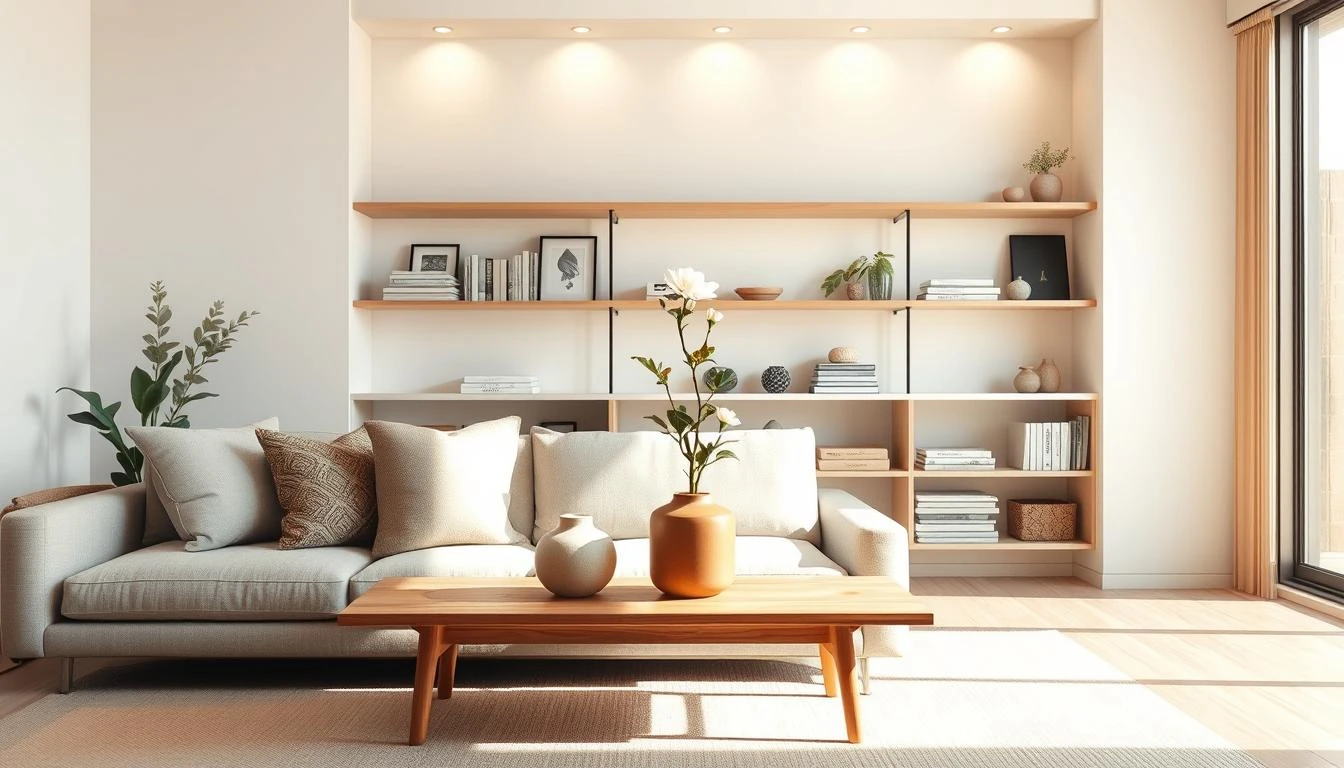
Have you heard of “Japandi” in interior design? It’s a mix of Japanese and Scandinavian styles. This blend creates a peaceful and harmonious living space.
This style focuses on minimalist decor and natural materials. It also uses clean-lined furniture. This makes your home calm and clutter-free. Japandi style brings together the coziness of Scandinavian design and Japanese simplicity.
In this article, we’ll dive into Japandi-inspired decor. You’ll learn how to bring this style into your home.
Key Takeaways
- Understand the core principles of Japandi-inspired decor
- Learn how to blend Japanese and Scandinavian design styles
- Discover the importance of natural materials and clean-lined furniture
- Create a serene and calming living space with Japandi style
- Get practical tips on incorporating Japandi decor into your home
The Origins of Japandi: Where East Meets North
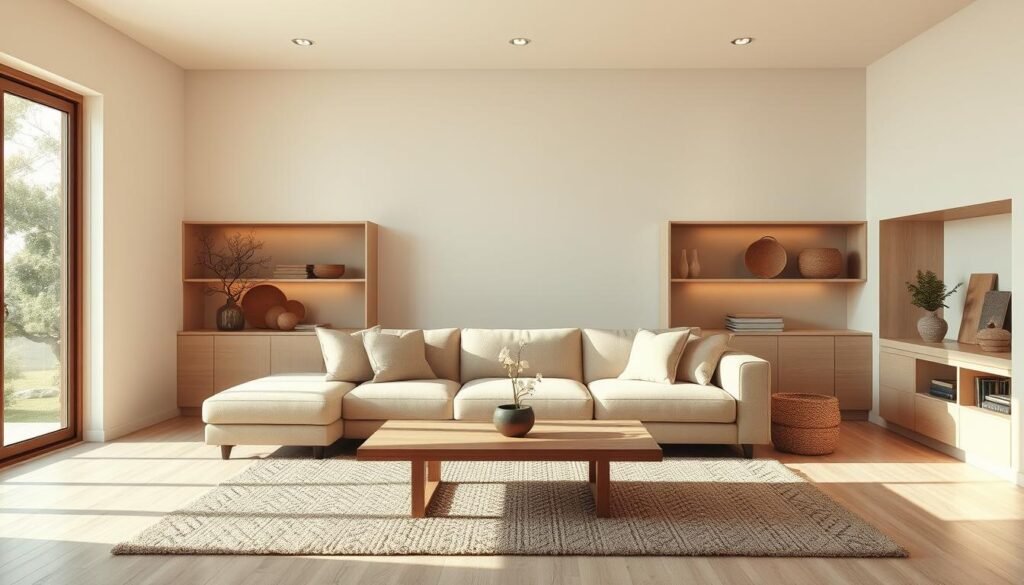
Japandi is a mix of ‘Japanese’ and ‘Scandinavian’ design. It values simplicity, function, and natural beauty. This style combines Scandinavian minimalism with Japanese elegance, creating a unique interior design.
Historical Context of Japandi Style
After World War II, Scandinavian design became famous for its simplicity and function. Japanese design was shaped by Zen, focusing on simplicity and natural materials. These two philosophies merged into Japandi style.
Key elements of Japandi design include natural materials, minimal decoration, and focus on function. It promotes a calm and tidy living space.
| Design Element | Japanese Influence | Scandinavian Influence |
|---|---|---|
| Material | Wood, Paper | Wood, Leather |
| Color | Neutral, Earthy | Monochromatic, Pastel |
| Furniture | Low-seating, Simple | Functional, Minimalist |
Adding Japandi elements to your home makes it more harmonious and minimalist. The mix of Japanese and Scandinavian design creates a calm yet sophisticated look.
Core Principles of Japandi-Inspired Decor
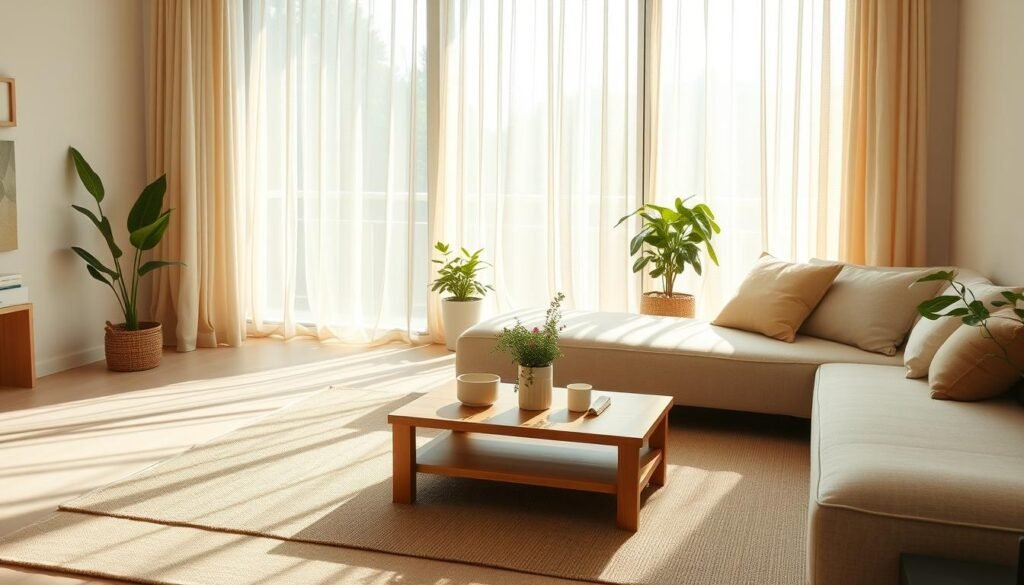
To get a Japandi-inspired look, you must grasp its core principles. These focus on minimalism and clean lines. Japandi style is more than looks; it’s about making your home calm and tidy.
One key part of Japandi decor is negative space. Leaving some areas empty helps create calm and balance.
The Role of Negative Space
Negative space is vital in Japandi decor. It lets the eye relax and adds simplicity. To use negative space, leave some walls blank or arrange furniture simply.
A good Japandi space also has clean-lined furniture. Look for furniture with simple designs that add to the zen feel.
| Design Element | Japandi Style | Traditional Style |
|---|---|---|
| Furniture | Clean-lined, minimalist | Ornate, detailed |
| Color Palette | Neutral, natural tones | Bold, vibrant colors |
| Negative Space | Emphasized, serene | Minimal, cluttered |
By following these principles, you can make a Japandi home that’s both stunning and peaceful. Use natural materials and a neutral color scheme to boost the minimalist vibe.
As you dive deeper into Japandi decor, remember it’s not just about looks. It’s about living a simple and serene life.
The Perfect Japandi Color Palette
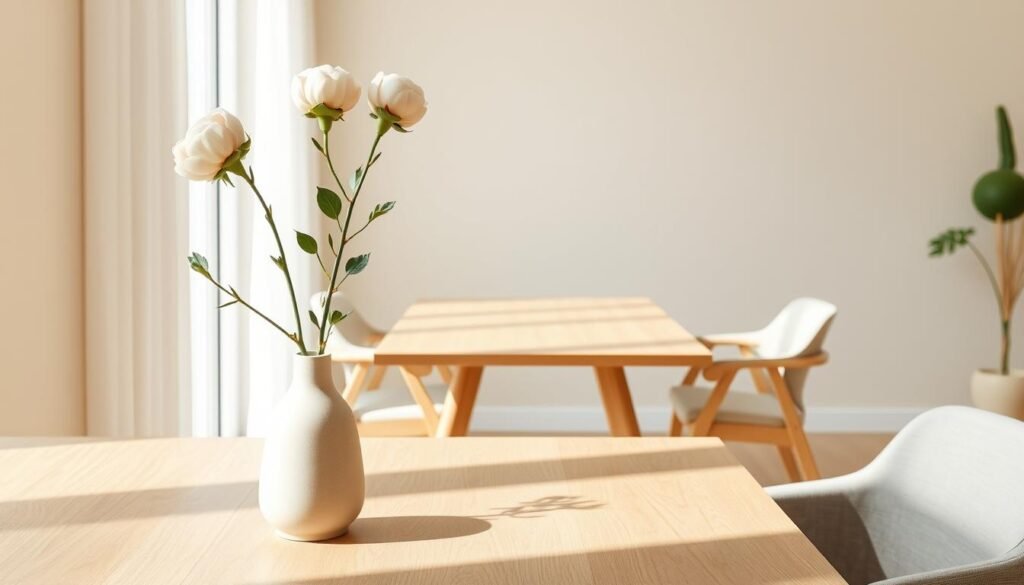
To get a Japandi look, focus on a neutral and earthy color palette. This mix combines Scandinavian simplicity with Japanese natural elegance.
The heart of Japandi’s colors are calming, natural shades. Think of soft whites, creamy beiges, and muted grays for a peaceful decor base. Earthy tones like taupe, sienna, and moss green bring warmth and depth.
Choosing colors for your Japandi space? Think about natural materials. Wood, woven fibers, and stone can guide your color choices. For example, wooden furniture’s warmth can be balanced by cool walls for a nice contrast.
To boost your Japandi colors, add subtle pops with textiles and soft furnishings. But keep these touches simple to keep the space calm. A well-chosen color scheme makes your home cozy yet elegant.
Furniture Selection for Japandi Spaces
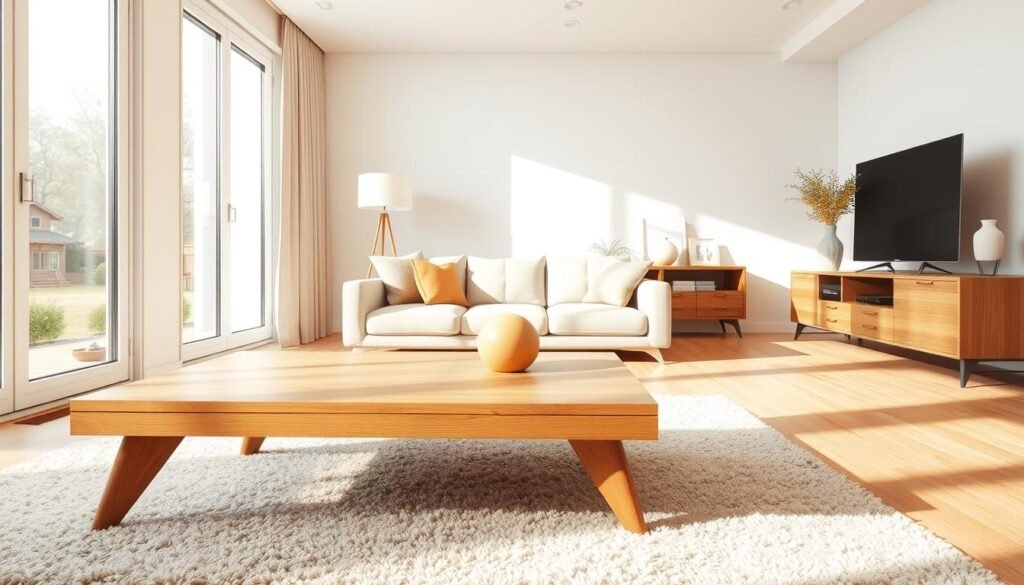
Choosing the right furniture is key to a Japandi-inspired space. You want pieces that are both stylish and calm. They should reflect Japandi’s minimalist style and add functionality to your home.
The Importance of Clean-Lined Furniture
Japandi furniture is known for its clean lines and simple designs. Clean-lined furniture keeps your space calm and clutter-free. Look for furniture with simple, elegant designs that don’t have too much decoration.
Functionality is as important as looks in Japandi decor. You need furniture that’s useful and fits the minimalist style. Think about pieces that can do more than one thing, like storage ottomans or coffee tables with storage.
Here’s a comparison of different furniture styles to help you make informed choices for your Japandi space:
| Furniture Feature | Japandi Style | Traditional Style |
|---|---|---|
| Design | Minimalist, clean lines | Ornate, complex |
| Materials | Natural woods, linen | Various, including synthetic |
| Functionality | Multi-functional | Single purpose |
By choosing clean-lined furniture and following Japandi’s minimalist principles, you can create a stylish and serene space. Keep things simple and functional to make your home a peaceful retreat.
Natural Materials That Define the Japandi Aesthetic
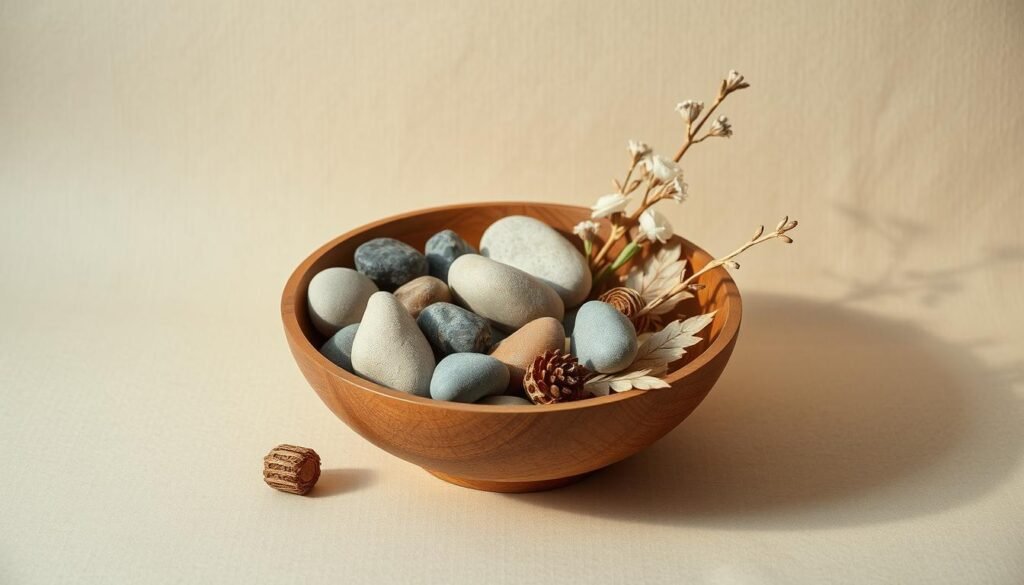
The Japandi aesthetic uses natural materials to warm up a space. You can bring this look to life with wood, stone, and plants.
Wood is key in Japandi design. It’s used for furniture, floors, and walls. Choose from oak, pine, or cedar to add texture and character.
Stone is also a big part of Japandi decor. It’s used for walls, fireplaces, or floors. It adds elegance and sophistication.
| Material | Characteristics | Uses |
|---|---|---|
| Wood | Warm, textured, versatile | Furniture, flooring, wall paneling |
| Stone | Elegant, durable, unique | Feature walls, fireplaces, flooring |
| Plants | Organic, refreshing, natural | Indoor gardens, decorative accents |
Using these natural materials makes a Japandi space feel warm and inviting. Make sure to balance them to keep the space feeling open.
Creating Your Own Japandi-Inspired Decor
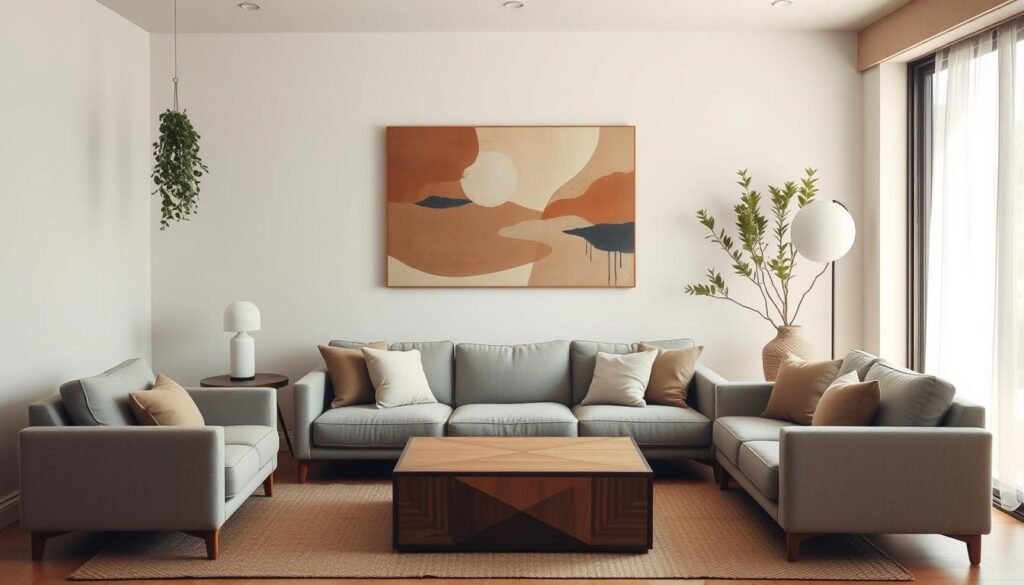
Making a Japandi-inspired space is more than just picking furniture. It’s about making a space that feels welcoming yet simple. To get this look, you need to mix Scandinavian simplicity with Japanese beauty.
Mixing Japanese and Scandinavian Elements
The heart of Japandi decor is blending different styles into one. Choose furniture that shows Scandinavian clean lines and function. Then, add natural materials and textures that feel like Japanese homes.
Balance is crucial in creating a Japandi space. Don’t fill the room with too much. Instead, pick a few pieces that bring calm and peace. Mix traditional Japanese items like shoji screens with Scandinavian textiles and furniture.
To make your space feel more natural, use materials like wood, bamboo, and wicker. These add warmth and texture. They also connect your space to nature, a key idea in both Japanese and Scandinavian design.
By carefully mixing these elements, you can make a Japandi decor that’s both stunning and practical. Your home will be a peaceful and beautiful place.
Textiles and Soft Furnishings in Japandi Style
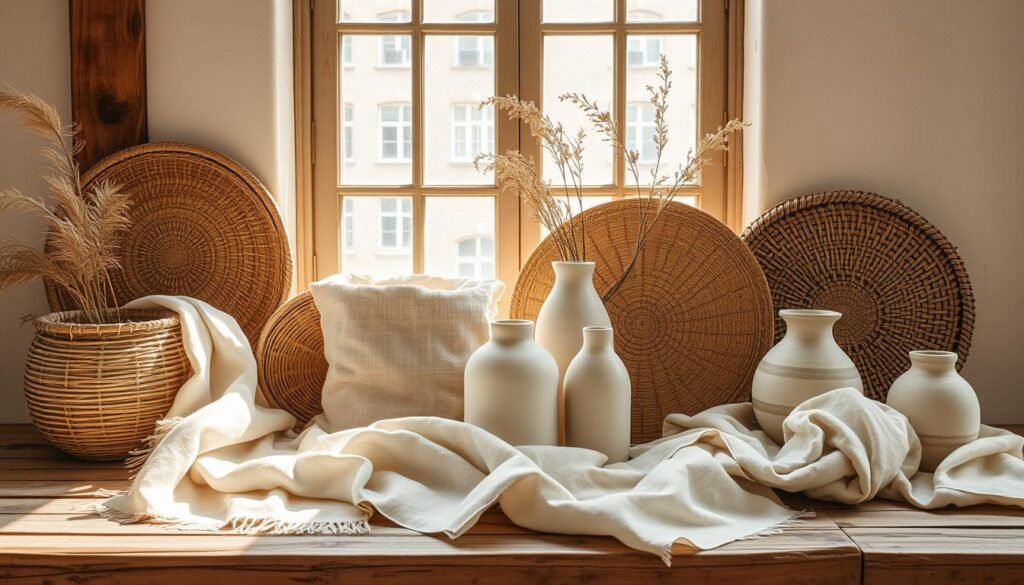
To get a true Japandi look, pick textiles and soft furnishings that are simple and natural. The Japandi style is all about minimalist decor and using natural materials.
Choose natural fibers like linen, cotton, and wool for your textiles. These materials warm up your space and bring a natural simplicity to Japandi design. Look for fabrics with soft patterns or textures that add depth without making things too busy.
For soft furnishings, pair clean-lined furniture with pillows, throws, and rugs that are minimalist too. Pick items with simple, geometric patterns or solid colors that match your color scheme. The aim is to balance different elements well without too many extras.
By focusing on simplicity, natural fibers, and soft patterns, you can make a Japandi-inspired space that’s cozy and calm. Remember, the goal is to make your clean-lined furniture and minimalist decor even better with the right textiles and soft furnishings.
Room-by-Room Guide to Japandi Design
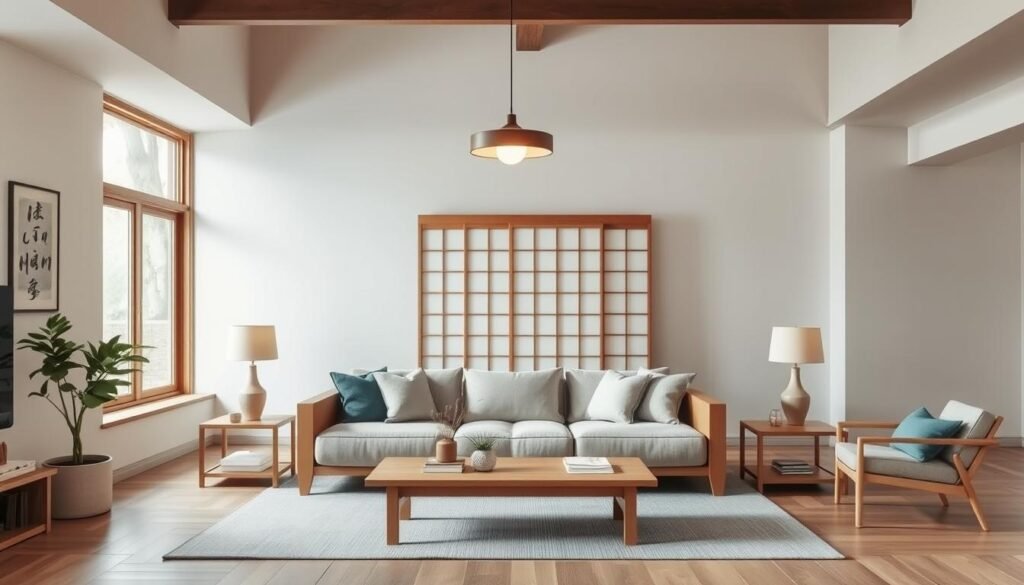
Starting your Japandi journey? Think about how it can make each room better. Japandi design mixes Scandinavian simplicity with Japanese elegance. It aims to create a calm, useful living space.
In the living room, choose simple furniture with straight lines. A neutral-colored, low sofa is a great start. Add touches like shoji screens or a tatami mat for a Japanese flair.
The kitchen should be tidy. Opt for natural materials for counters and cabinets. Add Scandinavian smart storage to keep things organized.
Imagine a living room with a Scandinavian wooden coffee table and a Japanese low-seating area. This mix makes a peaceful, balanced space. Use natural materials and minimalist decor to get this look.
Follow these tips for a unified Japandi feel in your home. The goal is to mix simplicity with usefulness. This creates a calm, welcoming vibe in every room.
To boost your Japandi decor, add textiles that show both Scandinavian and Japanese styles. Think throw blankets in natural fibers or cushions with nature-inspired designs.
Where to Shop for Authentic Japandi Pieces
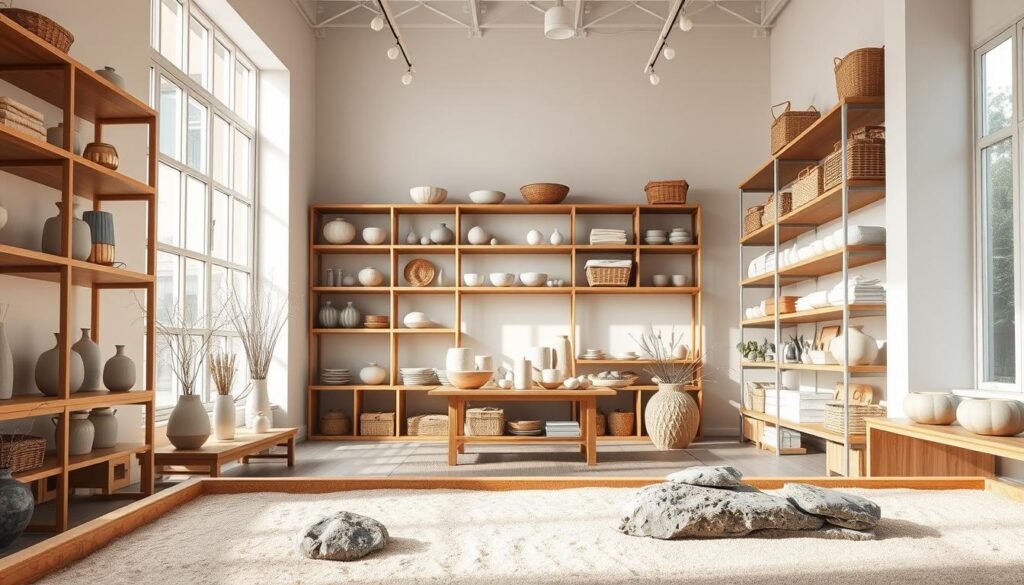
Bringing Japandi style into your home is easy with the right places to shop. Japandi decor mixes Scandinavian simplicity with Japanese elegance. This creates a unique, modern look.
Looking to add Japandi style to your home? Here are some top places to shop:
Online Retailers:
- West Elm – Known for modern, clean-lined furniture, West Elm is a great start.
- CB2 – This brand offers affordable Japandi-inspired pieces.
- MUJI – A Japanese brand known for minimalist, functional designs.
Physical Stores:
- IKEA – While not traditional Japandi, IKEA’s designs can fit the style.
- Local Artisan Markets – Perfect for unique, handmade Japandi decor.
When shopping for Japandi, look for materials and craftsmanship that show simplicity and function.
| Store | Type | Japandi Features |
|---|---|---|
| West Elm | Online | Clean-lined furniture, modern decor |
| MUJI | Online & Physical | Minimalist designs, functional pieces |
| Local Artisan Markets | Physical | Handmade, unique Japandi-inspired decor |
Shopping at these places lets you create a stylish, functional Japandi home.
Conclusion: Embracing the Timeless Beauty of Japandi Style
You now know all about Japandi-inspired decor. It’s a mix of Japanese and Scandinavian styles. This blend brings peace and elegance to your home.
The Japandi look focuses on natural materials and simple colors. It also values thoughtful furniture choices. These elements create a calm and nurturing space.
By using these features, your home will look better and feel more relaxing. Start embracing Japandi style today. See how it can change your living space for the better.
